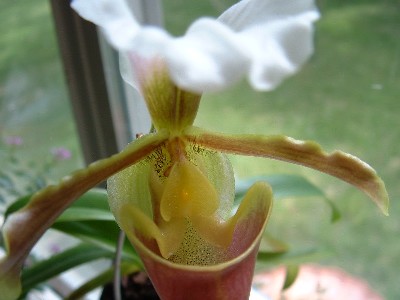~Val Eitreim
Paph. barbigerum 'Mauve Sheen' (from my collection)
Plants in the genus Paphiopedilum belong to the family Orchidaceae. The species name Paphiopedilum is derived from Greek and means "Venus' slipper". They are commonly called slipper orchids or lady slippers because of the 'pouch' or 'lip' on the flower that some say looks like a lady's slipper. Most plants in this genus are considered semi-terrestrial because they are usually found growing in leaf mould that has collected in rock crevices. Some do live more as terrestrials or epiphytes though. Most plants in the genus are found in tropical areas such as Tiawan, China, the Philipines, and surrounding areas. Paph. barbigerum is mostly found in isolated parts of China.

Paph. barbigerum '899' Copyright AnTec Laboratory
Paph. barbigerum is a very miniature orchid species. It's leaf span usually doesn't exceed eight inches at maturity and flowers are usually held on an inflorescence about two and a half inches tall. The leaves are medium green and narrow, with a flush of purple at the base of the plant. It's growths usually display a clumping habit, so a mature specimen can have many growths and still take up little space. This allows it to possibly bloom several times a year. The blooms of Paph. barbigerum can vary greatly in color from album forms to dark red. Colors in between include shades of pink, tan, peach, red, and sometimes an almost mauve/purple tint (the picture at top doesn't do it justice, but some of the purple tint is still slightly visible in the dorsal). The most common color form is usually red or brown. This trio includes a rare album, a red, and a tan barbigerum.

*Paph. barbigerum trio Copyright AnTec Laboratory
 Paph. barbigerum
flowers have the same basic structure as all of the flowers in the genus Paphiopedilum.
In this picture you can easily see the basic parts that make up the flower.
The top 'petal' pictured is actually the dorsal sepal. The horizontal portions
are
the true petals. The cup-shaped part of the flower is referred to as the lip
or pouch. In the center of the flower at the opening of the pouch is the staminode.
Behind and to the left of the staminode one of the pollen sacs is also visible.
The smaller, paler 'petal' behind the pouch is the synsepal.
Paph. barbigerum
flowers have the same basic structure as all of the flowers in the genus Paphiopedilum.
In this picture you can easily see the basic parts that make up the flower.
The top 'petal' pictured is actually the dorsal sepal. The horizontal portions
are
the true petals. The cup-shaped part of the flower is referred to as the lip
or pouch. In the center of the flower at the opening of the pouch is the staminode.
Behind and to the left of the staminode one of the pollen sacs is also visible.
The smaller, paler 'petal' behind the pouch is the synsepal.
Paph. barbigerum is a very good candidate for windowsill or under-light culture. Its low light requirements and small size make it an ideal orchid for a beginner. At first, growing Paphiopedilums might seem difficult. They are actually more different, than difficult to grow compared to other pot plants. This is a very brief set of guidelines. For more complete instructions I recommend visiting AnTec Laboratory's web site. Their FAQ's and Quick Start to Buying and Growing Your Own Paph. articles are the best place for a beginner to start.
A.Growing media: soilless mix including cocconut husk chips/bark as the main ingredient
B.Pot: a plastic pot with good drainage that just fits the root system of the plant plus a year or two worth of growing room
C.Light: low to medium (east-facing windowsill or under full spectrum flourescent lights is ideal)
D.Temperature: grows well at average room temperatures (the slight amount of heat from flourescent lighting can help simulate a drop in night-time temps. when they are turned off for the night)
E.Humidity: in the home, humidity should be kept as close to or above 50% as you can keep it with humidifiers and/of trays
F.Watering/Fertilizing: watering frequency will vary according to temp. and humidity 1)never let the plant completely dry out 2)use water that contains a very low level of salt (do NOT use softened water) 3)fertilize "weakly, weekly" with a urea-free orchid fertilizer
G.Blooming: 1)blooming time can vary, but usually buds are initiated in the fall 2)blooms usually last for one to three months at a time 3)growths need to mature before blooming and will bloom only once per growth
AnTec Laboratory - www.ladyslipper.com
Orchids Limited - www.orchidweb.com
Paphs.net - www.paphs.net
*Valerie Eitreim~October 2003